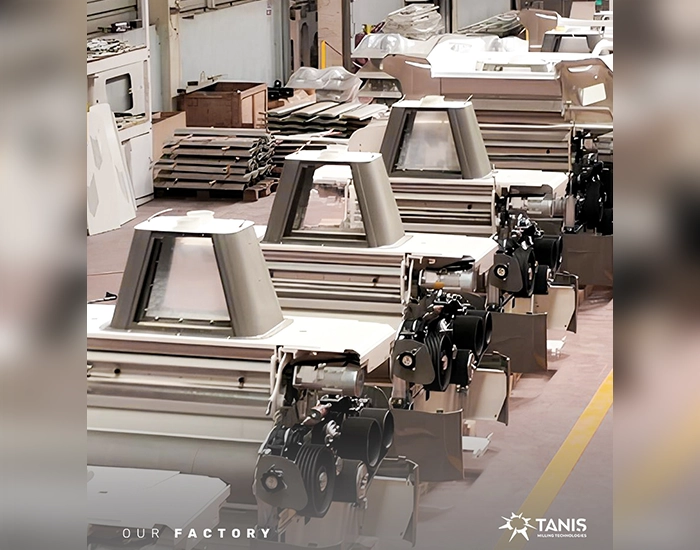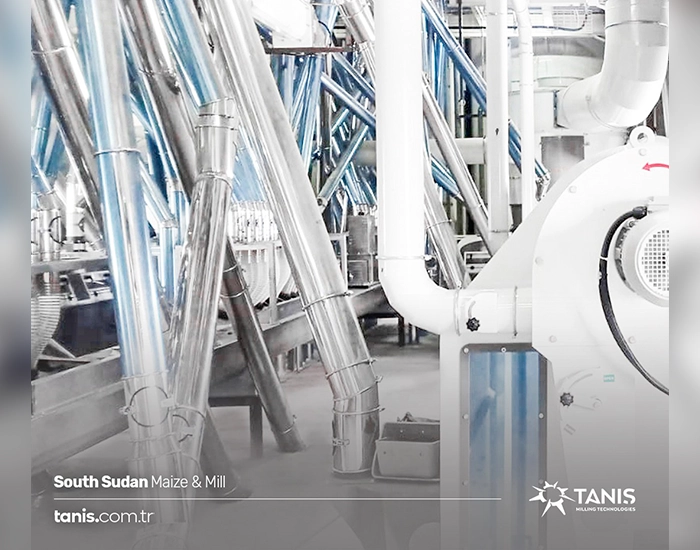The mill sector is experiencing rapid technological transformation in the face of increasing global food demand, changing consumer expectations, and sustainability requirements. Innovations brought by the Industry 4.0 and digitalization wave have begun to fundamentally change traditional milling approaches. As Tanış A.Ş., with over 60 years of industry experience, we lead future technologies and position ourselves as strategic partners in our customers’ digital transformation journey. In this content, we will comprehensively address the technologies that will shape the sector’s future, innovation trends, and the opportunities they will offer to businesses.
Mega Trends Changing the Sector
The increase in global population and urbanization creates growing pressure on efficiency and quality demands in food production. While the world population is expected to reach 9.7 billion by 2050, food production must also increase by 70%. This situation necessitates the transition to more efficient, sustainable, and smart systems in the mill sector.
Sustainability and resource efficiency are among the biggest challenges facing the sector. Optimizing energy and water consumption, reducing waste, and lowering carbon footprint have become priority targets for modern mill facilities.
The reflections of Industry 4.0 in the sector manifest themselves through data-driven decision mechanisms, smart sensor networks, and automation systems. This digital transformation increases operational efficiency while also strengthening product quality consistency and traceability.
Characteristics of Future Mill Facilities
Future mill facilities will be equipped with fully integrated smart systems, have autonomous decision-making mechanisms, and be self-optimizing structures. In these facilities, human intervention will be minimized while seamless data flow between systems and real-time analytics will ensure operational excellence.
Data-driven operations will enable transparent monitoring and analysis of the entire value chain from raw materials to final products. Cloud-based solutions and digital platforms will facilitate multi-facility management while offering centralized control and optimization opportunities.
Human-machine collaboration will create new working models in future mills. Operators will transition to strategic decision-making, analysis, and technology management roles rather than routine tasks. This situation will also transform the competency and skill requirements of the workforce.
Artificial Intelligence in Mill Operations
Artificial Intelligence (AI) technologies are bringing revolutionary changes to mill operations. The use of AI algorithms in process optimization and parameter adjustments can reduce energy consumption by 15-20% while increasing product quality by 10-15%.
Smart blend optimization and recipe development is one of the most effective application areas of artificial intelligence. Dynamic recipe optimization systems provide consistent final product quality despite changing raw material characteristics while optimizing raw material costs.
Product quality prediction and continuous improvement systems predict quality parameters of flour and other mill products in advance, providing proactive process control. This technology reduces waste rates while increasing customer satisfaction.
Image Processing and Machine Vision Technologies
Advanced image processing and spectral analysis technologies minimize human factors in grain classification and quality assessment while increasing accuracy and speed. AI-supported image analysis systems can detect grain color, size, shape, and defects within milliseconds.
Hyperspectral imaging technology enables non-destructive analysis of grain contents (protein, moisture, gluten, etc.). This technology can be used in all processes from raw material acceptance to final product quality control.
Machine learning algorithms can predict equipment failures hours or even days in advance. Continuous monitoring and analysis of vibration, sound, temperature, and other parameters allows real-time tracking of equipment “health status.”
Predictive maintenance systems can reduce unplanned downtime by up to 70% while lowering maintenance costs by 25-30%. They also optimize return on investment by extending equipment life.
IoT and Connected Production Systems
Smart Sensor Networks and Real-Time Monitoring
New generation IoT sensors collect data from hundreds of points in mill facilities, enabling real-time monitoring of process parameters. Critical variables such as temperature, humidity, pressure, speed, and vibration are continuously monitored to ensure optimum operating conditions.
Wireless sensor networks reduce installation and maintenance costs while providing a more flexible and expandable monitoring infrastructure. Energy-efficient communication protocols and long-life batteries make the use of sensors at many points economical.
Digital twins, which are virtual copies of physical facilities, are revolutionizing mill operations. These virtual models fed with real-time data flow not only reflect the current state of the facility but also enable simulation of different scenarios.
Digital twin technology allows testing the effects of new process parameters, equipment changes, or different raw material characteristics without putting the real facility at risk. It also creates an ideal platform for operator training and virtual commissioning applications.
Smart Automation and Self-Optimizing Systems
Adaptive control algorithms enable mill processes to automatically adapt to changing conditions. Learning systems can improve their performance over time and find the optimum operational point in terms of energy consumption, efficiency, and quality.
Advanced process control systems show much superior performance compared to classical PID controllers by modeling the relationships between complex variables. Technologies such as Model Predictive Control (MPC) can provide consistent product characteristics despite variable raw material quality.
Industrial Robotics and Autonomous Transport Systems
Robotic systems used in packaging and palletizing operations reduce labor costs while increasing efficiency and safety. Robots equipped with advanced vision systems and artificial intelligence can easily adapt to variable product sizes and packaging types.
Autonomous guided vehicles (AGV) optimize material flow in mill facilities and reduce human error. These systems integrated with RFID and similar technologies provide automation of inventory tracking and logistics operations.
Energy Efficiency and Smart Energy Management
New generation energy-efficient motors and variable speed drives can reduce energy consumption of mill facilities by up to 30%. Smart energy monitoring and management systems analyze energy usage in real-time and identify optimization opportunities.
Renewable energy integration reduces the carbon footprint of mill facilities while also minimizing fluctuations in energy costs. Solar energy, biomass, and other renewable sources are increasingly taking place in facilities’ energy portfolios.
Water Efficiency and Waste Management Technologies
Smart water usage and recycling systems can reduce water consumption of mill facilities by 40-50%. Advanced filtration technologies and closed-loop systems enable water reuse while minimizing wastewater quantities.
By-product utilization and zero waste production approaches increase the economic and environmental sustainability of mill facilities. Converting by-products such as bran and germ into value-added products both reduces waste quantities and creates new revenue sources.
Our R&D and Innovation Studies
As Tanış A.Ş., we conduct comprehensive R&D and innovation studies to lead the technologies shaping the sector’s future. In our technology development laboratories in Istanbul and Ankara, we develop innovative solutions in artificial intelligence, IoT, energy efficiency, and sustainable production areas.
Through projects carried out in collaboration with leading universities and research institutions, we transform academic knowledge into industrial applications. Our TUBITAK-supported projects and international partnerships strengthen our innovation capacity.

Our Technology Solutions and Pilot Applications
Our AI-supported process optimization system “OptimAI” increases energy efficiency by 18% and product quality consistency by 22% in mill operations. Our IoT-based predictive maintenance solution “PredictMill” reduces unplanned downtime by 65% while lowering maintenance costs by 28%.
Our digital twin technology “TwinMill” enables virtual modeling and optimization of mill facilities. This technology allows testing new investments and modernization projects without taking risks.
Technology Journey with Our Customers
As strategic partners in our customers’ digital transformation journey, we provide technology consulting and evaluation services. Our technology readiness assessment, digital maturity analysis, and roadmap creation services facilitate businesses’ systematic adaptation to future technologies.
We support our customers’ risk-controlled digital transformation through pilot technology projects and phased transition strategies. Our training and competency development programs enable technical teams to effectively use new technologies.

Frequently Asked Questions
We recommend starting technology integration with a comprehensive assessment of your current situation. Our technology readiness assessment service includes analysis of your existing systems and processes, determination of your digital maturity level, and identification of priority opportunity areas. Following this assessment, a phased roadmap specific to your business is created.
Modular and scalable solutions stand out for small and medium-scale mills. Cloud-based monitoring systems, energy-efficient motor drives, simple automation upgrades, and mobile application-supported quality control systems are technologies that can provide maximum benefit with limited budgets. With a phased approach, a transition from basic digitalization steps to advanced technologies can be planned.
Based on our experience, predictive maintenance systems, energy management solutions, and process optimization technologies are investments that provide the fastest ROI. These technologies can typically amortize themselves within 12-24 months. However, since each facility’s unique conditions and priorities are different, conducting a business-specific analysis would be the most accurate approach.
Conclusion and Call to Action
Technological transformation in the mill sector has become an inevitable process. Businesses that adopt future technologies today gain significant competitive advantages in efficiency, quality, and sustainability areas. As Tanış A.Ş., we will continue to lead the sector’s technological future and be reliable partners in our customers’ digital transformation journey.
